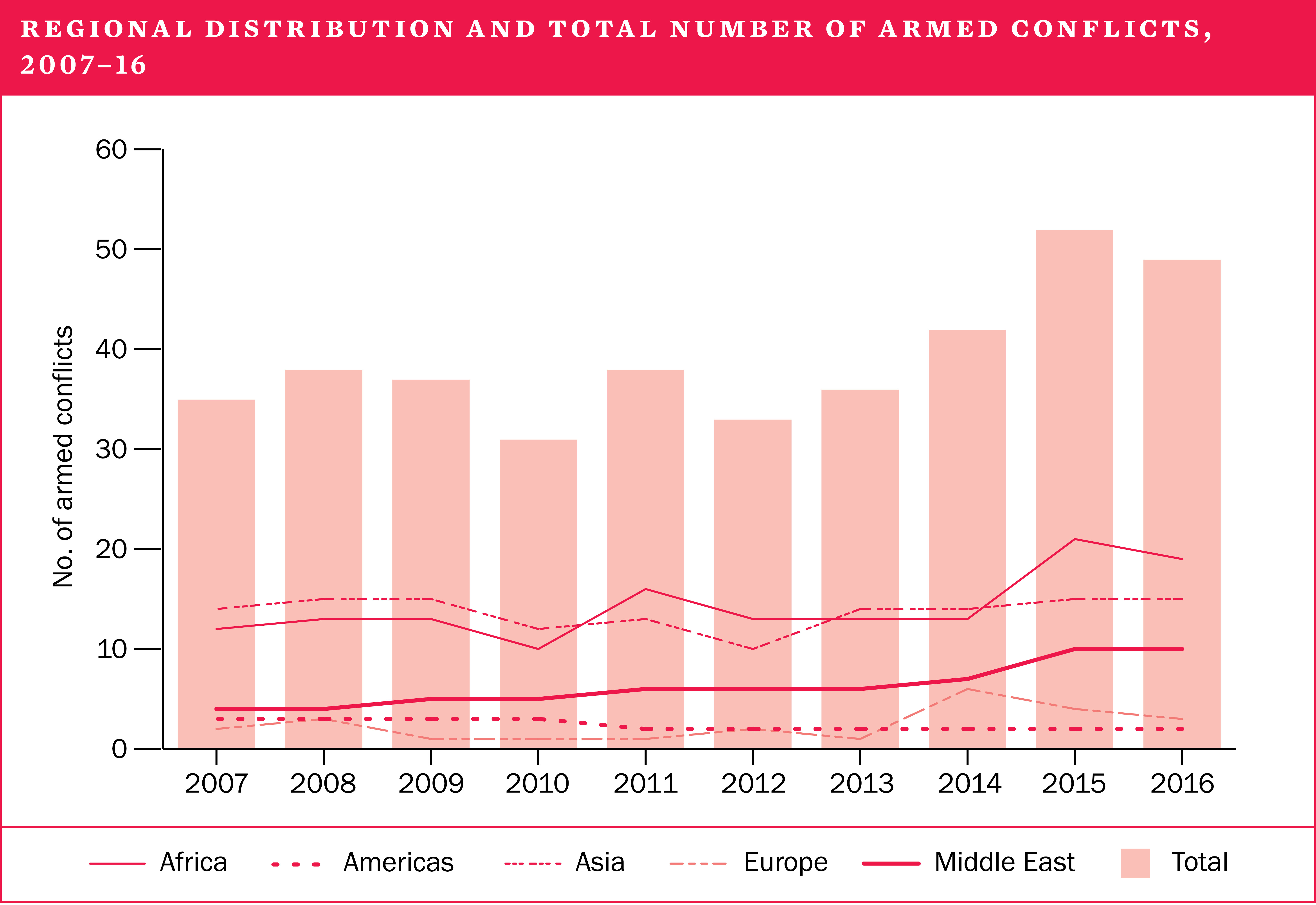2. Armed conflict and peace processes
Overview, Ian Davis [PDF]
I. Patterns of organized violence, 2007–16, Margareta Sollenberg and Erik Melander [PDF]
II. Out of the darkness? The hope for peace in Colombia, Pedro Valenzuela [PDF]
III. Mapping armed conflicts over Islamist claims: exploring regional variations, Desirée Nilsson and Isak Svensson [PDF]
IV. The Global Peace Index 2017, Camilla Schippa and Thomas Morgan [PDF]
Patterns of armed conflict, 2007–16
The pattern of armed conflict and peace processes in 2016 appeared to confirm the recent trend for a reversal of the post-cold war peace, but the picture is mixed. According to the Uppsala Conflict Data Program (UCDP), for example, the number of active armed conflicts decreased from 52 to 49 in 2016. However, despite this reduction, 2016 confirms the trend for there to be a significantly larger number of conflicts in the past three years compared to the period 2007–13. Comparisons over a longer period show that the number of armed conflicts in recent years has been equivalent to the number in the period 1990–92. The two periods 1990–92 and 2014–16 constitute two distinct peaks in the post-cold war era. Much of the increase in the number of conflicts in 2014–16 stemmed from the spread of the Islamic State (IS), which often transformed active conflicts and led them to be recorded as new conflicts in UCDP data.
Of the 49 active conflicts in 2016, 2 were fought between states (India–Pakistan and Eritrea–Ethiopia) and the other 47 were fought within states and over government (22), territory (24) or both (1). There is a clear recent pattern for a larger share of intrastate conflicts to involve troops from other states on the side of one or both of the warring parties. In 2016 over one-third
(38 per cent) of intrastate conflicts were internationalized in this way. Most of these (13 out of 18) were fought against Islamist organizations.
The UCDP recorded 12 wars—defined as an armed conflict that results in 1000 battle-related deaths—in 2016, one more than in 2015. Three of the wars listed in 2015 had de-escalated to the level of a minor armed conflict in 2016 (Nigeria, Pakistan and Ukraine). Four previously recorded conflicts escalated to the level of war: Afghanistan–IS, Libya–IS, Turkey–IS and Turkey–Kurdistan. Africa was the region with the highest number of conflicts in 2016 (19 active conflicts) followed by Asia (15 conflicts). Ten conflicts were recorded in the Middle East, three in Europe and two in the Americas.
Conflict-related developments have been discouraging in recent years, not least in the Middle East, but not all the changes have been negative. While many conflicts were initiated or escalated, many others ceased to be active or were de-escalated. The reduction in the number of conflicts in Latin America is particularly noteworthy. After the 2016 peace agreement between the Revolutionary Armed Forces of Colombia–People’s Army (Fuerzas Armadas Revolucionarias de Colombia–Ejército del Pueblo, FARC–EP) and the Government of Colombia, and with ongoing negotiations with the National Liberation Army (Ejército de Liberación Nacional, ELN), the only guerrilla group still in conflict with the Colombian Government, it seems likely that the region will soon have no active conflicts.

Islamist armed conflicts
About one-third of the world’s Islamist armed conflicts are taking place in the Middle East and North Africa, one-third in sub-Saharan Africa and the rest largely in Asia. In some cases, an escalation can be observed over time from not necessarily religiously framed opposition to explicit Islamist grievances, followed by a transformation into transnational Islamist aspirations. The need to recognize and constructively manage this type of conflict at each step of its escalation, and seek to resolve it has important implications for conflict prevention policy. South East Asia stands out as a region that is bucking the empirical trend, where the proportion of Islamist armed conflicts seems to be decreasing.